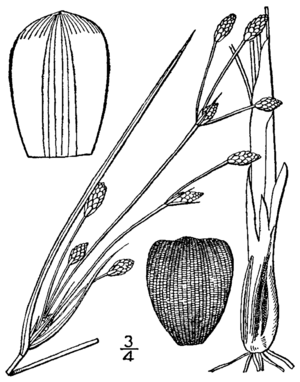Marsh fimbry facts for kids
Quick facts for kids Marsh fimbry |
|
|---|---|
 |
|
| Scientific classification | |
| Genus: |
Fimbristylis
|
| Species: |
castanea
|
The marsh fimbry, also known as saltmarsh fimbristylis, is a special type of plant. Its scientific name is Fimbristylis castanea. This plant is a perennial sedge. This means it's like a grass, but it lives for many years. It belongs to the Cyperaceae family, which includes many grass-like plants. The marsh fimbry grows naturally in the United States of America.
What Does Marsh Fimbry Look Like?
The marsh fimbry can grow quite tall, up to about 1 m (3 ft 3 in) (which is about 3 feet). It often grows in thick groups, like a big clump of grass. Its leaves are thin and grow from the very bottom of the plant. These leaves are a dark brown color near the base. They are also quite strong and sturdy. The leaves can grow to be about half to two-thirds the height of the whole plant.
This sedge has tiny flowers. These flowers are usually hidden behind dark, shiny, brown scales. These scales form small, bud-like shapes called spikelets. Think of spikelets as little clusters where the flowers are tucked away.
Where Does Marsh Fimbry Grow?
You can find the marsh fimbry in the southeastern parts of the United States. It grows from Texas all the way east and north along the coast. Its range extends as far north as New York.
This plant loves wet, salty places. It often grows in salt marshes, which are coastal wetlands flooded by ocean water. You might also see it on coastal sand dunes. It can even grow in brackish water marshes further inland. Brackish water is a mix of fresh and salty water. It especially likes areas near wharves, which are docks where boats tie up.

